Superior Grow Lights: Easy build your own
What grow lights do I need for growing Fast Plants? That’s an important question. However, it also may be the start of a missed learning opportunity, if we’re not mindful.
Consider for comparison your reaction when a student asks: “What do I need to know for the test?” Likely, your response includes hoping this student becomes more invested in their learning. Similarly, the grow light question posed as: “What lights do I need for growing Fast Plants?” can oversimplify or bypass some key scientific questions about energy and plants that are also valuable to consider. So, in this post, we take the time to discuss grow lights in ways that can help us understand and teach more deeply with Fast Plants.
In the end, this post includes complete plans and a downloadable shopping list for an inexpensive, do-it-yourself (no tools needed) grow light that is ideal for growing Fast Plants. In fact, once you understand more about measuring energy from light for plants, this light could be built and adjusted to grow all sorts of garden seedlings and other plants.

In addition to plans for an easy-to-build grow light, this post discusses:
- Natural phenomena that many of us can relate to, connecting energy availability and seedling growth.
- Basics concepts related to how we understand scientifically the energy from light available for plants.
- Measuring energy from light with a free app that allows you and your students to make data-driven decisions about how to set up grow lights for Fast Plants.
- Why we recommend full spectrum LED grow lights, along with complete instructions for building a PVC grow light stand that is particularly well-suited for growing Fast Plants in your classroom.
If you can’t wait to know more about the new grow lights we’ve designed, here are the basics, with more specifics and details at the end of this post:
Build your own grow lights stand for Fast Plants and other seedlings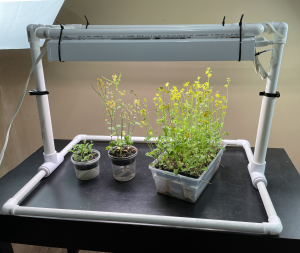
- Purchase online or from a home building supply or hardware store (total cost currently is just over $100; though, price of the GE Grow lights is fluctuating and varies greatly by vendor):
– Two 24″ length GE full spectrum LED grow lights for seeds and greens.
– Three sizes of PVC cut to length at the store according to the downloadable shopping list (available at the end of this post).
– All the PVC tee fittings, elbows, and reducer bushings as specified on the shopping list.
– Small pack of 14″ zip ties (minimum of 4 needed).
– White (non-expansive) Gorilla Glue
2. Purchase online or from a local bicycle shop: 2 quick-release seat clamps, size 1-3/8″ (34.9mm) diameter.
3. Assemble the PVC light frame as shown at the end of this post (using Gorilla Glue to fix junctions), and zip tie one grow light to each arm.
4. Assemble PVC stand as shown (using Gorilla Glue). Then glue the PVC light frame into the stand.
5. Using the quick-release seat clamps, adjust the distance between the soil surface of your particular growing system and the grow lights. Determine this height by measuring PAR at the height of the soil, making sure that all growing systems receive a minimum of 200 µmol m⁻² s⁻¹. Read on to learn an easy way to take this measurement!
Keep reading for an in-depth look at grow lights for plants. Just as our grow light plans are free for noncommercial use, you’ll find no advertisements in our blog posts to interrupt your reading. Given the commitment of the Wisconsin Fast Plants Program of UW-Madison to providing Open Education Resources, please enjoy that resources on our website are unencumbered by ads.
Click here to Download PDF for Easy Fast Plants LED Grow Light Assembly Instructions
Phenomenon: Seedlings grow from seeds and need light
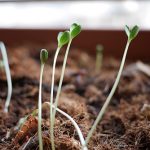
Seedlings push aside their seed coats and tiny plants emerge. Whether in nature or cities, this amazing phenomenon takes place all around us. And yet, the cycle of growing plants is a great mystery; it is filled with wonder and teachable moments.
Whether we begin by taking a closer look at the seedlings outside or by growing a small population of Fast Plants from seed in the classroom, we can easily observe differences in how individual seedlings grow. We can notice variation in seedlings’ stem length, leaf sizes and color, rates of growth, and more. As a result of noticing, we then can ask: What causes this variation among seedlings?
Light and seedlings
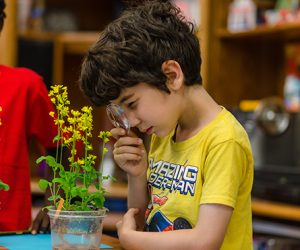
Some variation that we observe among seedlings is caused by genetic differences, and some variation is caused by environment. If we focus first on environment, then we can deepen our understanding about what plants need. Further, since the need for energy from light is critical for plants, focusing on how light is related to variation among seedlings can be powerful.
In addition, considering how light affects seedlings is critical for preparing classroom conditions to successfully grow healthy plants. In fact, how we set up grow lights is essential when our intentions are for students to tend and observe Fast Plants through their entire life cycle. In other words, having students mess about with various light configurations to conduct controlled experiments is great; however, as teachers we need to establish optimal lighting and model scientific practices for doing so. In brief, we now ask the question: How do we design optimal lighting conditions for Fast Plants?
Optimal lighting for seedlings

Let’s pause briefly to consider: Why all this focus on seedlings instead of older plants when discussing energy from light? To help answer this question, consider how human infants are particularly sensitive to their environment. Similarly, rapidly growing baby plants (seedlings) are greatly affected by environmental factors, especially light. As a result, we can easily observe variation in seedling structures (like stem length and leaf size) and differences in growth rates between seedlings with ample light and those without. Generally speaking, Fast Plants seedlings grown with optimal lighting conditions have short, stocky stems and grow at the fast rate for which they are named. On the other hand, Fast Plants seedlings that lack sufficient energy from light have thin, elongated stems and a reduced growth rate.
Of course, this leads us back to ask: How do we design optimal lighting conditions for Fast Plants? Often, we turn to growing instructions for guidance. Typically, Fast Plants kits and step-by-step instructions recommend the wattage and type of light bulbs to use and specify the distance between light source and plants. However, these are procedural descriptions, not scientific measures or explanations (though they are likely based on scientific measures). Further, such procedural steps cannot guarantee that lighting conditions in your particular situation will be optimal.
Instead, if we reason scientifically when designing the lighting for growing Fast Plants, we can figure out how to make our light conditions optimal. With the goal to reason scientifically about our grow lights comes a need for being able to measure the energy output of our lighting set up. Fortunately, agronomists, botanists and other scientists study how plants use energy from light, and engineers develop methods for quantifying the energy in light that is useful for plants.
Lumens are for humans, not plants
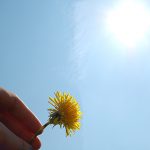
Brightness that we can see from a light source is not a good measure of the light a seedling needs. As a result, measuring light available for plant growth and development needs to be done with a tool that detects the intensity of specific wavelengths. Fortunately, there’s an App for that! However, before we get into the specifics about measuring energy from light for plants, consider how that is different than other ways we measure light (for example, light for our homes).
Typically, when we shop for light bulbs, we compare Watts. Watts tell us how much energy input a light requires. Here is a useful definition of Watt from the Illuminating Engineering Society (IES):
WATT: A watt is a unit of power denoting the rate at which electricity is used. For humans and when most all lighting was incandescent bulbs, Watts were a useful measure because the electricity input was directly related to the total light intensity output, which is measured in lumens.
So, watts are a measure of electricity input, and we say lumens are for humans because *lumens are a measure of output, or the brightness of a bulb that is relevant for humans. However, what matters for grow lights isn’t watts or the lumens they can emit; rather, what matters is how much usable light will actually reach your plants. Therefore, one key concept to understand about energy from light and plants is that there is a difference between how humans sense light intensity (measured in lumens) and the way plants absorb and use light.
This difference between how humans sense light and how plants use light is why we need to measure the light output from grow lights with different types of instruments than used to measure light intended for humans. As a result, we measure energy from grow lights in PAR photon irradiance (often abbreviated as just PAR). Therefore, the scientific way to discuss energy from light for plants is as PAR, which is measured in units of micromoles per square meter of area per second (abbreviated µmol m⁻² s⁻¹).
PAR is for grow lights
What do PAR measurements tell us? First, PAR or photosynthetically active radiation is defined by the range of wavelengths that are known to be important for plants, and it corresponds with the visible spectrum (the light wavelengths the human eye can see).
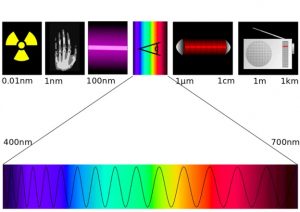
**We know that some wavelengths within the PAR range promote stem and leaf growth, while others may contribute to flowering. In general, scientific experiments demonstrate that red and blue light wavelengths are especially important for plants. Above all, we understand scientifically that the wavelengths emitted by grow lights used for Fast Plants effect how the plants are able to grow throughout their life cycle. As a result, we recommend for Fast Plants grow lights that emit a full spectrum of light in the PAR range with an emphasis in the red and blue wavelengths.
In addition to a particular range of wavelengths, PAR measurements take into consideration light intensity. In scientific terms, PAR is quantified as photosynthetic photon flux density (PPFD), the sum of photons in the wavelengths between 400 and 700 nanometers.
Before your eyes glaze over, grappling with the units for measuring PAR (µmol m⁻² s⁻¹) we need to discuss light intensity. In addition to a particular range of wavelengths, PAR measurements take into consideration light intensity. In scientific terms:
PAR is quantified as photosynthetic photon flux density (PPFD), the sum of photons in the wavelengths between 400 and 700 nanometers.
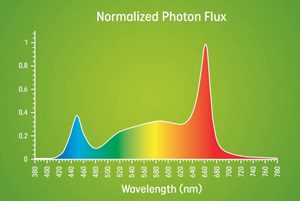
Keep in mind, regardless of the type of light source you choose for growing Fast Plants, that source has a fixed light energy output (intensity). Therefore, the only way to increase or decrease the energy from a particular grow light that is available to your plants is to change the distance between plants and light source.
In fact, the relationship between light intensity (output) and the distance from a light source is well understood as a physical law, (called an inverse square law). So, we can apply the inverse square law to know that distance matters in how grow lights are positioned in relation to the soil surface and young seedlings. Keep in mind that distance from the light source includes both vertical and horizontal proximity. Consider how some lights are built more like a spot light and others emit light widely. Therefore, the “footprint” beneath your light source where Fast Plants seedlings can receive sufficient energy is a function of overall output, including directional light intensity.
Measuring and quantifying grow light output
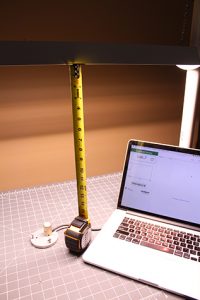
Now, can you see how measuring and interpreting grow light output can offer valuable learning opportunities associated with growing Fast Plants? Of course, students need to measure and use evidence in forming explanations about lights and plants. So, we need tools for students to take relevant light output measurements. Unfortunately, scientific sensors used for measuring PAR cost hundreds of dollars. Fortunately, there’s an app for that! Others reported and we confirmed with side-by-side tests that Photone, an App for iPhone, iPad, and Android Smartphones, is plenty accurate for both preparing lighting for Fast Plants and conducting controlled light experiments. (Note: At the time we designed this light, the Photone meter for full spectrum, sunlight was free, and that was the setting used to compare with our Apogee PAR meter.) Since this light project, we’ve also heard of (but not tested) other PAR meter apps that work well.
Measuring light with a PAR meter brings us back to the phenomenon described at the start: how energy from light relates to variation among seedlings. Given the variation in lights, it makes sense that different grow lights will cause variation in how seedlings grow and develop. Remember, we’ve highlighted how grow lights can vary in:
- Wavelengths emitted
- Intensity
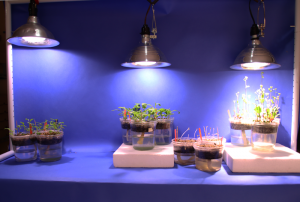
In addition, electric light sources vary in the amount of heat they emit (e.g. fluorescent bulbs emit more heat than LEDs), and that can effect seedling growth and development, too. Therefore, temperature in the Fast Plants growing environment is another valuable environmental variable to measure and record. Overall, students can interpret results from growing Fast Plants best when they use scientific practices to measure and record as many environmental variables as possible.
In summary, an important way we can support students to learn with Fast Plants begins when we first start preparations to grow. When we begin by asking the question, How can I design optimal lighting conditions for Fast Plants? and model how we figure it out, students can learn by example. Then later, when we notice variation among seedlings , we can use our understanding of the relationship between light and plants to wonder more deeply about how environmental factors may have caused the differences we see.
For a great example of how variation in light availability causes differences in growth and the development of reproductive structures (flowers) in Fast Plants, click here to check out this timelapse video we made in our lab.
Building your own cost-effective LED grow lights
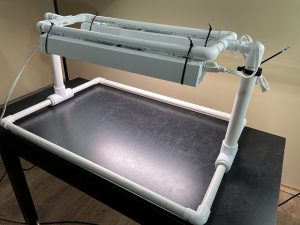
Building grow lights for Fast Plants that deliver optimum lighting is easier than ever, now. With these plans, grow lights for Fast Plants can be easily built by imply purchasing off-the-shelf LED grow lights and using PVC pipe that can be cut at the time of purchase and joined with standard PVC fittings.
- Purchase online or from a home building supply or hardware store(total cost currently is just over $100; though, price of the GE Grow lights is fluctuating and varies greatly by vendor):
– Two 24″ full spectrum LED grow lights. We recommend these for seeds and greens made by GE.
– Three sizes of PVC cut at the store according to the downloadable cut-sheet. These are common sizes with broad availability, and most all stores that carry PVC also have tools available on site to cut everything to length (as specified on the cut-sheet).
– All the PVC tee fittings, elbows, and reducer bushings as specified.
– Small pack of 14″ zip ties (minimum of 4 needed).
– White (non-expansive) Gorilla Glue
2. Purchase online or from a local bicycle shop: 2 quick-release seat clamps, size 1-3/8″ (34.9mm) diameter.
3. Assemble the PVC light frame as shown at the end of this post (using Gorilla Glue to fix junctions), and zip tie one grow light to each arm of the frame.
4. Assemble PVC stand as shown (using Gorilla Glue). Then glue the PVC light frame into the stand.
5. Using the quick-release seat clamps, adjust the distance between the soil surface of your particular growing system and the grow lights. Determine this height by using the app Photone to measure PAR at the height of the soil in your growing system at all positions beneath the light that you plan to use. Be sure that all growing systems receive a minimum of 200 µmol m⁻² s⁻¹.

This light was carefully designed, using a PAR meter so the entire footprint (outlined by the frame of the base) is able to receive a minimum of 200 µmol m⁻² s⁻¹ (PAR) at the height of a deli container growing system, when the light frame is in its lowest position.
Why we recommend LED grow lights
The most important reason for choosing LED grow lights is because they are better for our environment than other types of grow lights. From the Illuminating Engineering Society’s online introduction to lighting basics (which has no marketing agenda) we can learn several key reasons why LEDs are quickly transforming the grow light world:
“LED lighting is fundamentally different from conventional light sources such as incandescent, fluorescent, and gas-discharge lamps. An LED uses no mercury, no lead, no gas or filament, it has no fragile glass bulb, and it has no failure-prone moving parts. LED sources are super green! They do not contain mercury (as do CFLs) or lead (as do incandescent lamps). LED lighting is more efficient, durable, versatile and longer lasting than incandescent lighting. … In a well-designed product; LEDs are basically cool to the touch [and emit visible light as specific colors].” Source: Illuminating Engineering Society
Robert Morrow, of Orbital Technologies Corporation, wrote in an article for the journal HortScience, “… the use of light-emitting diodes (LEDs) is potentially one of the biggest advancements in horticultural lighting in decades.”
Resources for learning more about Grow Lights
LEDs in horticulture: Mitchell, C.A., M. P. Dzakovich, C. Gomez, R. Lopez, J. F. Burr, R. Hernandez, C. Kubota, C.J. Curry, Q. Meng, E.S. Runkle, C.M. Bourget, R.C. Morrow, and A.J. Both. Light-emitting diodes in horticulture. In: J. Janick (ed) Horticultural Reviews Volume 43: 1-87.
Phillip Davis’ Technical Guide called Lighting: The principles, available free online https://horticulture.ahdb.org.uk/sites/default/files/u3089/Lighting_The-principles.pdf
Cooper’s informative 2007 article in LEDs Magazine: https://www.ledsmagazine.com/articles/print/volume-4/issue-8/features/driving-led-lamps-some-simple-design-guidelines.html
All about measuring PAR from Apogee–scientific leaders in this industry: https://www.apogeeinstruments.com/content/Comparison-of-Eight-Quantum-Sensor-Models.pdf
Energy Education Project from the University of Calgary’s Physics Department: https://energyeducation.ca/encyclopedia/Main_Page
Digi-Key, 2016 https://www.digikey.com/en/articles/techzone/2016/dec/choosing-lenses-to-make-the-most-of-led-lumens
Domitrovich’s article, A Look at Solid State Lighting in the International Association of Electrical Inspectors Magazine, March-April 2014. https://iaeimagazine.org/magazine/2014/03/04/a-look-at-solid-state-lighting/
*For more about lumens and human lighting, The Department of Energy has a straightforward resource: https://www.energy.gov/energysaver/lumens-and-lighting-facts-label
**What we currently understand about the wavelengths utilized by plants is just the tip of the iceberg. Every day we are learning more and more about how plants use energy from light.


